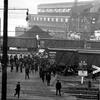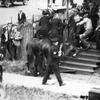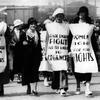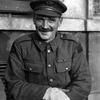8. Ballantyne Pier and Other Battles
The harsh putdown of the On-to-Ottawa Trek was the last nail in the political coffin of R.B. Bennett. On October 14, 1935, William Lyon Mackenzie King and the federal Liberals cruised to a crushing electoral victory. The Liberals soon closed the federal relief camps and repealed Section 98 of the Criminal Code, which had been used to jail communists. On the union front in BC, there had been few bright spots. As demand and prices plunged, hard-pressed employers wasted little time slashing wages, imposing longer hours and reducing workplace standards. Rare was the union or worker who complained. Most felt lucky to be employed at all when so many were not.
But there were occasions when the boss went too far, and workers showed their fight. One of the most significant battles took place early in 1931 at Western Canada Lumber in Fraser Mills, just east of Vancouver. One of the world’s largest timber operations, WCL tried to impose a fifth wage cut in twenty months. The mill workers said no. They were also angered by the firing of employees who refused to work overtime. Many had joined the revived Lumber Workers Industrial Union, now an affiliate of the Workers’ Unity League, still trying to secure a toehold in the province’s number-one industry.
The workforce at Fraser Mills was one of the most diverse in British Columbia. While white workers predominated, a large number of them were French Canadians, their BC roots stretching back more than twenty years when the company had recruited a large number of employees from Quebec. They were now well ensconced in their own nearby community, Maillardville. Contingents of Nikkei, Chinese and South Asian labourers also worked at the mill.
It was the kind of ethnic division that had doomed so many strikes in the past, but that did not happen at Fraser Mills. Unlike the Vancouver Trades and Labor Council, which continued to campaign for Asian exclusion, the Workers’ Unity League welcomed workers of all races. Only half the six hundred workers carried union cards when the strike began, but membership from all groups grew significantly during the hard-fought conflict.
Following strong rejection of the company’s wage cut, picket lines went up at the sprawling site on September 17, 1931. The head of the strike committee was shingle weaver Harold Pritchett, already an experienced union activist at the age of twenty-seven. Demands included a 10 percent wage increase, time and a half for overtime, union recognition and an end to the nefarious contract system for Asian workers. On the first morning, spirited picketers popped the cigar from the mouth of company manager Henry Mackin before allowing him to pass.
Tension mounted on day two. The union’s picket line was bolstered by 150 recruits from the National Unemployed Workers’ Association, another WUL affiliate. Melees broke out, bringing squads of provincial police to the scene. They were aided by a “Special Watch” of armed company guards who patrolled the grounds night and day. The mill entrance was further protected by a mounted machine gun.
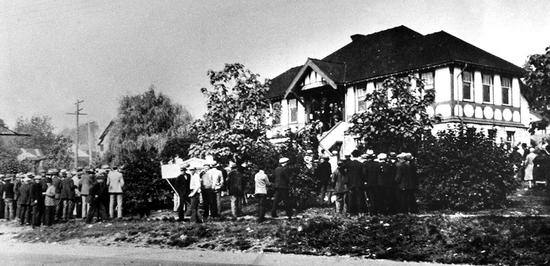
The next day, police plunged into the hundreds of picketers to make ten arrests, while the usual suspects trotted out their familiar accusations of political troublemakers stirring up the workers. Premier Simon Fraser Tolmie warned of “agitators and communists,” while Attorney General R.W. Pooley said the government would not stand for “imported radicals” to foment trouble. Neither the strikers nor their families were cowed. When those arrested appeared in court, fifty schoolchildren walked out of class to join a demonstration in front of the courthouse, “led by a determined looking lady with a stout stick,” according to the British Columbian newspaper.
An uneasy truce took hold. But three weeks later, hurt by the shutdown of a subsidiary mill in Comox, the company blinked. Mackin agreed to rescind the wage cut, increase shingle rates, cap weekly hours at forty-eight and meet regularly with a committee of mill workers. All in all, it was not a bad offer. But there was no union recognition—and the strikers, their combativeness sharpened by the company’s original intransigence, were not ready to settle. At a raucous meeting, they voted unanimously to reject the proposal.
Spirits and resources were bolstered by dances, picnics, sports events, a relief kitchen run by women supporters to provide meals for single men, a “Bumming Committee” to solicit donations of food and money, and organized bartering of skills and services such as haircuts, shoe repair and cutting wood for fuel.
In its minutes, the strike committee noted, “[A] Japanese comrade was appointed to the Relief Committee, also a Hindu and a Chinaman. They were very successful.” Nikkei farmhands in the region donated vegetables, while others raised cash within their own communities. The tightly knit French Canadians were the strike’s greatest strength. Even an outrageous intervention by the local parish priest could not fracture their solidarity. Denouncing “communists and radical revenge,” Father François-Xavier Teck told his flock he would not grant absolution to anyone holding a union card. Few complied, and the union arranged transportation for Sunday mass to a more welcoming church in New Westminster.
Yet there was no more give from the company, and the loss of regular pay gradually reduced the strikers’ willingness to carry on into the winter. On November 20, they voted by a large margin to return to work under the company’s October offer. Still, in a precarious economic environment, they had made real gains against a stubborn employer. Although there were far more hurdles to overcome, the Fraser Mills strike was the first step forward in the arduous but ultimately successful unionization of the BC forest industry.
The result was also a tribute to the leadership of the strike, which pulled together the many disparate elements of the workforce to take on a powerful timber company. It didn’t matter to the men that the struggle was led by members of the Communist Party. They backed whoever would support their fight for a better deal. Said LWIU president George Lamont as the strike began, “We intend to fight the Fraser Mills company and the Federated Timber Mills of BC, not on the basis of communism but on the basis of bread and butter.” It was a recipe CP trade unionists followed with considerable success over the next decade and a half in the push to organize the province’s major industries.
Despite the party’s wealth of activity and organizing, most socialists steered clear of communism. Although just as convinced by the Depression that capitalism had broken down and a new system was needed to deliver prosperity for all, they had no interest in a dictatorship of the proletariat. In late July 1932, a group of left-wingers from a quilt-like variety of organizations met at the Calgary Labor Temple to hammer out a less extreme socialist alternative to the Communist Party. In the forefront was Independent Labour MP J.S. Woodsworth. He had deep roots in BC, including several years as a union longshoreman in Vancouver, while his daughter Grace had just married his House of Commons seatmate, Vancouver South MP Angus MacInnis.
Over a mere two days, the one hundred or so delegates put aside their many differences to choose Woodsworth as leader and form a leftist political party that continues today as the NDP. The ungainly titled Co-operative Commonwealth Federation was soon referred to far and wide as simply the CCF. A year later, the CCF held its first national convention to build a party platform. The famous Regina Manifesto, hailed by leading British socialist Harold Laski as the best democratic-socialist document ever put together, called for public control of key industries, publicly funded health care, universal pensions, income-based taxation, abolition of the Senate, a planned economy, an end to profit-driven chartered banks and a national labour code that would “secure for the worker maximum income and leisure, insurance covering accident, old age, and unemployment, freedom of association and effective participation in the management of his industry or profession.”
“I am convinced that we may develop in Canada a distinct type of socialism,” said Woodsworth. “I refuse to follow slavishly … the Russian model.” Workers and others beaten up by the system rallied to the CCF’s paler red flag in a way they never had to the hammer and sickle. The fresh approach was soon felt in BC. In its first crack at an election, the CCF won enough seats to form the province’s official opposition in 1933.
Among its seven new MLAs were Ernest Winch and his twenty-six-year-old electrician son, Harold. At the local level, successful CCF candidates included long-time trade unionist Helena Gutteridge, the first woman elected to Vancouver city council. Although there were no official ties until its 1961 alignment with the Canadian Labour Congress (CLC) as the New Democratic Party (NDP), the CCF was considered “labour’s party” from the beginning, consistently attracting widespread support from workers and unions in BC.
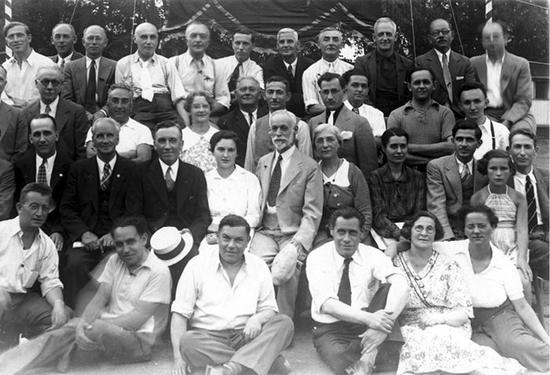
Far from the provincial legislature, there were other labour flare-ups in the Dirty Thirties. Miners in the isolated town of Anyox, far up the Portland Canal north of Prince Rupert, joined the left-wing Mine Workers’ Union of Canada (MWUC) and walked off the job in early 1933 to protest a wage cut and the high cost of room and board. Intimidated by large numbers of armed police sent in by boat from Prince Rupert who arrested strikers and strutted menacingly about the community’s wooden boardwalks, the miners voted to go back to work. But more than three hundred single men soon left, robbing Anyox of its heart.
Not long after that was the courageous miners’ strike in Princeton, and in 1934, twenty-five hundred fallers on Vancouver Island revolted against their low pay, long hours and abysmal working conditions. The dispute featured a celebrated long march by more than a hundred strikers over a mountain and through the bush to escape company detection and confront a bunch of strikebreakers. When they arrived, they found machine guns and “a cop for every [scab] they had,” said union leader Ernie Dalskog. “There was no way we could force them out.” The logging companies eventually agreed to a wage increase, but the fallers’ bid for more fell short after ninety-six days off the job. Industrial disputes peaked in 1935. Days lost from strikes and lockouts were nearly double the previous year’s total, and that did not include the two-month strike by relief camp workers.
The familiar recipe was played out in particularly harsh terms yet again early in 1935 in Corbin, a small coal-mining community tucked into the southeast corner of the province. The Corbin Miners’ Association, formerly supporters of the OBU and now affiliated with the radical MWUC, had been agitating for some time to improve their rock-bottom company housing. Miners were also angry about recent pay cuts and worried the American-owned company was about to shut its underground operation, throwing many of them out of work. But pickets did not go up until January 22, after the company fired union secretary John Press. Over the next few months, Corbin was riven with tension over the presence of provincial police brought in to spy on the strikers and guard the narrow ledge of a road leading to the mine.
Matters came to a boil in mid-April. A large number of picketers led by a group of wives headed through the snow toward the mine. As they approached, a bulldozer suddenly drove forward into the middle of the women, running over their legs and dragging one of them three hundred feet before she could get free. Enraged miners began hurling rocks at the police who followed the bulldozer, swinging clubs as they advanced. Several dozen strikers and fifteen police were injured. For three days, seventeen arrested strikers were confined in two tiny cells. But the injuries suffered by the miners’ wives caused the most outrage. A picture of eight women taken a few days after they were mowed down showed some with bandaged feet and crutches, others with their heads wrapped in bandages.
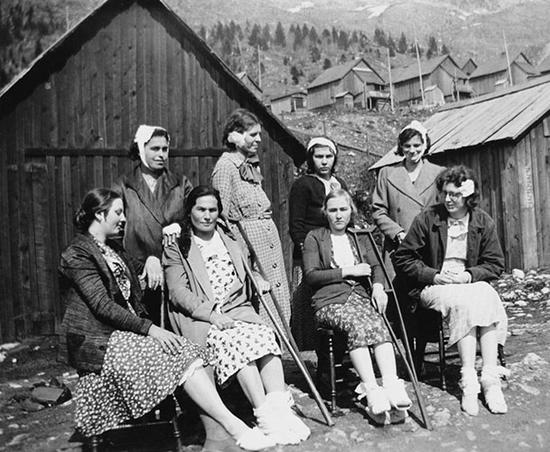
Fundraising campaigns sprang up in BC and nearby coal-mining communities in Alberta. An independent commission headed by three CCF MLAs exposed the miners’ dreadful living conditions, but the provincial government was unmoved. Predictably, the trouble was blamed on the usual outside agitators and the Workers’ Unity League. Six strikers were eventually jailed for up to six months for their role in the confrontation with police. The bulldozer driver was not charged. In the face of growing public anger, the owners announced the closure of mining operations in Corbin. Although the skeptical miners, buttressed by outside funds, maintained their strike for many more months, the government hastened the town’s demise by cutting off funds to its only doctor, who had no choice but to leave. When the CPR tore up the tracks leading to the mine, the miners accepted their fate. They scattered to find work where they could, and Corbin died.
In Vancouver, meanwhile, the hundreds of striking relief camp workers were not the only headache for the city’s excitable mayor, Gerry McGeer, during the spring of 1935. Trouble was also brewing on the waterfront. Just as during the relief camp strike and other disputes, the dreaded “Reds” were in the thick of it. On the docks, a surprising thing had happened to the company union formed by the Shipping Federation after wiping out the International Longshoremen’s Association in 1923. As the Depression deepened and waterfront companies increasingly squeezed their workers, the Vancouver and District Waterfront Workers’ Association (VDWWA) had become militant.
Resentful of a poor three-year agreement they had accepted reluctantly in 1934, union members chose a strong new executive. Business agent Oscar Salonen belonged to the Workers’ Unity League. So did Ivan Emery and George Brown, who had been elected president and secretary respectively of the Longshoremen and Water Transport Workers of Canada, a federation representing maritime worker organizations all along the BC coast. Its largest affiliate was the VDWWA. Each of the three men had at least ten years’ experience on the docks.
The union began pressing for a wage increase and an end to company control over the longshore hiring hall. The latter issue was critical. Vancouver was the only West Coast port without a fair, union-run dispatch system. Stevedores in the United States had won control of their halls the previous year after an exceptionally violent three-month strike that cost six union lives. But Vancouver companies were resolved not to relinquish their right to pick and choose who got to work. No wonder two-thirds of those who took part in the 1923 strike never worked another shift on the waterfront.
The two sides continued to butt heads through the spring of 1935. The ongoing strike by relief camp workers added to the tension. Waterfront workers were strong supporters of the strike, staging an hour-long sympathy walkout on April 29, and booking off for an entire shift two days later to head the large May Day parade.
With relief camp strikers already in the streets and a waterfront shutdown looming, McGeer believed revolution was nigh. Over the radio, he railed about the need for citizens to make a choice between the “constituted authority” and “communism, hoodlumism and mobs.” The next day, the mayor led four hundred police on a show of force. At the Beatty Street Drill Hall, military instructors began training squads of police to combat insurrection. On May 29, a vigilante group of prominent residents organized by the Shipping Federation bought full-page newspaper ads swearing that “ruthless Radicals” would not be allowed to imperil prosperity.
When the relief camp strikers made their spur-of-the-moment decision to launch the On-to-Ottawa Trek, McGeer, the Shipping Federation and police were now free to focus completely on the waterfront. On June 4, 1935, a day after the first contingent of trekkers headed east, Vancouver longshoremen refused to unload a shipload of “hot” newsprint from the strikebound docks of Powell River, where dock workers and seamen had walked out in mid-May. The companies quickly dispatched boats from the Vancouver Yacht Club carrying strikebreakers to handle the load and cancelled their union contract, and the fight was on. As in 1923, the Shipping Federation relished the opportunity to crush a union for having the temerity to stand up for its members’ rights. This time they were also able to harness the anti-Red hysteria of police commanders and the mayor.
On day one, the province agreed to send McGeer two hundred more provincial police to aid his crusade against communism. Vancouver Sun columnist Bob Bouchette was one of the few in the media to see through the mayor’s vitriol. “The strike isn’t about communism,” wrote Bouchette. “It’s about working conditions and whether the union will be broken.” He noted that most union members were married with families and with many years’ experience on the docks. “Are these the men who, we are told, are helping fomenters of revolution? The question does not merit a reply.”
But the companies’ ability to keep the port operating was a problem. At a union meeting on June 16, members decided to march en masse to the docks to “talk” to the scabs. In a blistering speech, Ivan Emery avowed, “[This strike] will be won by going down on ships and taking off strikebreakers … If we are refused [by police], we are going through anyhow.” Referring to the number of World War I veterans in the union, Emery added with a flourish, “We have heard the rattle of machine guns. I believe we have enough ex-servicemen on the waterfront who are prepared to listen to them again.” Emery too was a vet, having served in the same battalion as Vancouver Police Chief William Foster.
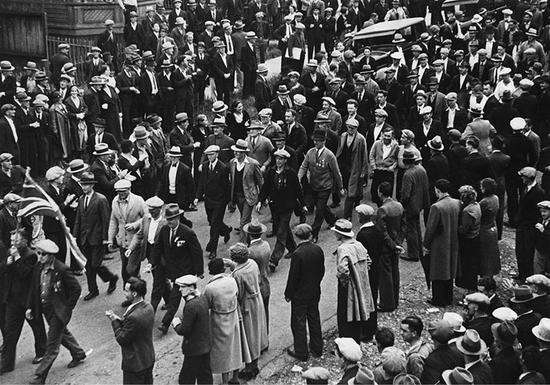
Early on the afternoon of June 18, 1935, a thousand strikers and supporters marched down Heatley Avenue toward Ballantyne Pier. At the head of the grimly determined demonstrators carrying the Union Jack was the city’s war hero, Victoria Cross winner Mickey O’Rourke. Said to be the second-most decorated Canadian soldier after flying ace Billy Bishop, the fifty-six-year-old casual dock worker had won the foremost award for military valour in World War I as a stretcher bearer during the horrendous Battle of Hill 70 that followed Vimy Ridge. A group of fellow vets followed behind, their war medals pinned prominently to their shirts and sweaters. As they marched, the men sang songs from the war. The defiant Ivan Emery was missing from the march. He’d already been carted off to jail and charged with inciting a riot. But business agent Oscar Salonen was there, right beside O’Rourke.
A host of edgy cops, two manning machine guns, waited at the tracks. “Just a minute, boys,” Chief Foster told the marchers. Not another step, he warned. Salonen was not deterred. “This strike has been going on long enough,” he told the chief. “We’re going in there, and we’re going to take these scabs off the boats.” A small scuffle broke out. Foster lowered his raised gloved hand, and all hell broke loose. For the first time, volleys of tear gas were deployed in Vancouver. The marchers, gasping for breath, their eyes stinging, began to flee. Police charged after them, swinging their clubs. They were joined by provincial police and RCMP reinforcements who had been hiding behind some boxcars.
The chase went on through the streets, alleys and yards of East Vancouver. A newspaper photo showed a lone striker on an empty street, no threat to anyone, about to be hit by a whip brandished by a cop on horseback. Other police rode their horses right to the front steps of houses to pursue and beat their prey. Some strikers responded with rocks. One officer was dragged out of his car and beaten. Another was knocked off his horse and attacked. But by and large, the Battle of Ballantyne Pier was a one-sided affair. “They’d hit you over the head. They’d hit you anywhere,” remembered striker Ted Hovi.
A temporary first-aid station hastily set up at the Ukrainian Labor Temple treated dozens of injured strikers. Some bystanders were also injured, including a woman just doing her shopping. Police launched tear-gas attacks on the offices of the VDWWA and the Workers’ Unity League. Still, police were unable to gain total control of the streets until 5 p.m. As for Mickey O’Rourke, police claimed they hustled him away from the chaos to safety. O’Rourke had a different story: “When I saw we were beat, I beat it, but not before I heaved a brick at a mounted policeman’s head.”
The next day, a triumphant McGeer cut off relief payments to strikers’ families. Emery and Salonen each received three months in Oakalla prison for unlawful assembly. Fifteen rank-and-file strikers were given sentences ranging from three months to a year. Despite the mounting odds against them, members maintained the strike. Those who could pitched in to help. Some caught fish. Others grew vegetables. Volunteers cut hair and repaired shoes. There was a strong Ladies’ Auxiliary to rally support, including the formidable Mildred Dougan. Given the option of a $25 fine or thirty days for assaulting police officers while on the picket line, Dougan chose jail. “The money is needed for relief more than it is by the police court treasury,” she said.
But with hundreds of strikebreakers keeping the port open, police guarding the waterfront, the Vancouver Trades and Labor Council taking a hands-off attitude and money shortages becoming acute, the strike was called off on December 9. After a valiant five-month struggle, the VDWWA was broken, as were all other coastal locals. The Shipping Federation retained its iron grip on the province’s ports. Hundreds of workers were again blacklisted from employment on the docks, and another company union replaced the VDWWA. Every year on the anniversary of the Battle of Ballantyne Pier, union dock workers gather at a waterfront memorial to remember those who marched for union rights on that bloody day in Vancouver history.
The fishing industry also showed fight during the Depression. After their epic strikes at the turn of the century, BC fishermen had garnered few of the riches that continued to fill the pockets of the province’s powerful canners. The same was true of fish-plant workers. The situation worsened just before the Depression. A major industry consolidation thrust BC Packers Ltd. into a dominant position, claiming nearly 50 percent of the 1929 salmon catch. The company used its enhanced prominence to pad profits by offloading more and more costs onto fishermen. At the same time, owing to a big rise in the number of licences, individual fishermen were bringing in fewer fish, further cutting into their incomes. In 1934, The Voice of the Fishermen calculated that with all the expenses and fees imposed on fishermen, their return for five weeks of labour was a loss of $30.
In the canneries, with a workforce 15 percent Chinese, 15 percent Nikkei and the remainder almost all Indigenous women, workers toiled eleven to twelve hours a day under onerous, piece-rate contracts. For two hard months, their average take-home pay was $80 to $100, not enough to keep anyone off relief.
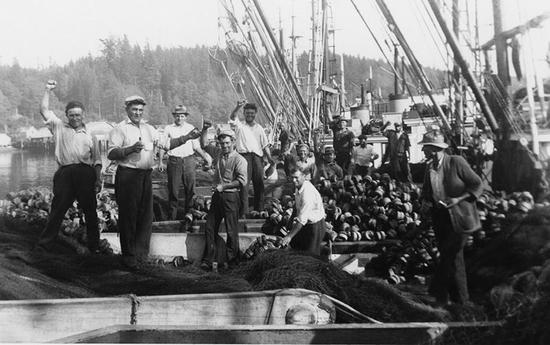
Anxious to challenge the industry, many fishermen joined the Fishermen’s Industrial Union, formed in 1932. Another affiliate of the Workers’ Unity League, the FIU was the first in a long string of communist-led unions in the fishing industry. “Is it any wonder that many fishermen are radicals?” one observed, pointing to the canners’ unstinting efforts to exploit them. Two years later, the FIU became the Fishermen and Cannery Workers Industrial Union, accepting fishermen and shore workers of all races. By 1936 in the salmon-fishing hot spot of Rivers Inlet, the union was ready to take a stand. After the industry cut the price per fish from fifty to forty cents, a thousand Central Coast fishermen voted 85 percent to strike; they tied up on July 6.
On the water, it was undeclared warfare. Strikebreaker nets were cut, their catches seized. Police aimed guns at striking fishermen to protect the scabs. Kitchens in the communal village of Sointula turned out bread and other provisions to help feed isolated fishermen who were denied access to company stores. The strikers, many Nikkei and Indigenous fishermen among them, held firm for a full month. But the companies refused to budge, and the season was essentially lost. The result was particularly devastating to the First Nations. “What we lost was not just a job,” said skipper Billy Assu, whose son Harry’s seine boat was featured for years on the $5 bill. “Fishing is our living, our way of life. We own these waters and we have to be able to fish them.” Convinced they could no longer trust non-Indigenous organizations to safeguard their interests, Aboriginal fishermen formed the Pacific Coast Native Fishermen’s Association.
Not lost, however, was the value of sticking together. After winning an arbitrated settlement in 1937, fishermen struck again in 1938. This time it was a seine-boat show centred in Johnstone Strait. Indigenous and non-Indigenous vessel owners alike backed the tie-up. But the canneries continued their usual hardball, cutting off credit at company stores and ordering fishermen to return their equipment. They did, but not before carefully dismantling the gear to make the nets useless for further fishing. Unbowed, the striking seiners headed for Vancouver, famously sailing into port under the new Lions Gate Bridge in two grand columns of thirty boats each. What appeared to be another season-long standoff suddenly turned in the union’s favour when many coastal gillnetters joined the strike. In a rare capitulation, the canners signed the first-ever coast-wide pricing agreement.
Although choppy waters remained ahead, the bold strikes of 1936 and 1938 far up the coast from the busy Fraser River set unionization of the BC commercial fishing industry on a course that would only go forward in the years ahead. In a verbal confrontation during the 1938 strike that became union lore, one-eyed fisherman John Hanson corrected a company negotiator who had inquired what price fishermen were asking. “We are not requesting,” Hanson proclaimed. “We are making our demands.” Whipping open the drapes of the company’s dockside office, he pointed to the idled fleet outside. “And there’s our solidarity. You get on the phone and tell Vancouver that.”
The Japanese Camp and Mill Workers’ Union also showed spunk during the difficult decade. Despite ongoing hostility from some within the Nikkei community who backed Japan’s rightward drift, membership in the union remained relatively strong. By the end of the decade, the JCMWU had eight locals, representing two-thirds of the province’s eighteen hundred Nikkei lumber workers.

